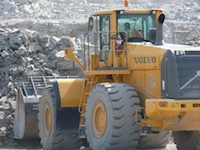
 January 21, 2014, Goteborg, Sweden – No harmful emissions, and
January 21, 2014, Goteborg, Sweden – No harmful emissions, and
no contribution to the greenhouse effect. At the end of December 2013, Volvo Construction
Equipment's site in Braås, Sweden, completed its journey towards becoming
carbon dioxide neutral. It is the first construction equipment production
facility in the world to be powered entirely by renewable energy.
 January 21, 2014, Goteborg, Sweden – No harmful emissions, and
January 21, 2014, Goteborg, Sweden – No harmful emissions, and
no contribution to the greenhouse effect. At the end of December 2013, Volvo Construction
Equipment's site in Braås, Sweden, completed its journey towards becoming
carbon dioxide neutral. It is the first construction equipment production
facility in the world to be powered entirely by renewable energy.
The 45,000 m2 site which specializes in the design and
manufacture of articulated haulers is now powered entirely by wind, biomass and
hydropower.
The achievement follows in the footsteps of the Volvo Group
Truck facility in Ghent, Belgium, which set the standard for emissions-free
industrial manufacturing in 2007. And just as Ghent became the first carbon
neutral facility in the automotive sector, Braås too becomes the first in its
respective industry.
"As one of our core values, environmental care informs
everything we do at Volvo," says Niklas Nillroth, Volvo CE's vice
president of Core Value Management & Corporate Social Responsibility.
"So we are extremely proud that the Volvo Group is leading the way, not
just in one industry, but two."
Braås' first step towards carbon neutrality began in 1999,
when it commissioned local energy supplier Växjö Energi AB to install a district
heating plant, fuelled by wood chips, to provide central heating for its
employees — and the town's residents. Braås then joined a Volvo Group
initiative in 2007 that saw it switch to green electricity (i.e. generated from
renewable sources).
These first two initiatives brought the site's level of CO2
neutrality to 87 per cent in 2008, with the final push to reach 100 per cent
beginning two years ago. Staff identified the greatest source of energy
consumption as the liquefied petroleum gas burners, which were used to heat the
rust protection treatment ovens to 60degC. These were systematically replaced
from September 2013 with district heating. The burners in the component paint
shop, which reach temperatures of 120degC, were also altered to electrical
heating. In addition, the site's diesel forklifts were substituted with
electric battery models.
Meanwhile, locals and the site's 1,000 employees challenged
Växjö Energi AB to run the district heating plant on biomass only — regular
oil had previously also been used during peak times and maintenance. "This
is a tremendous achievement driven by the dedication and tenacity of employees
at Braås," says Nillroth. "But we couldn't have achieved it without
the ready availability of green power in Sweden and the support of our local
community."
Print this page